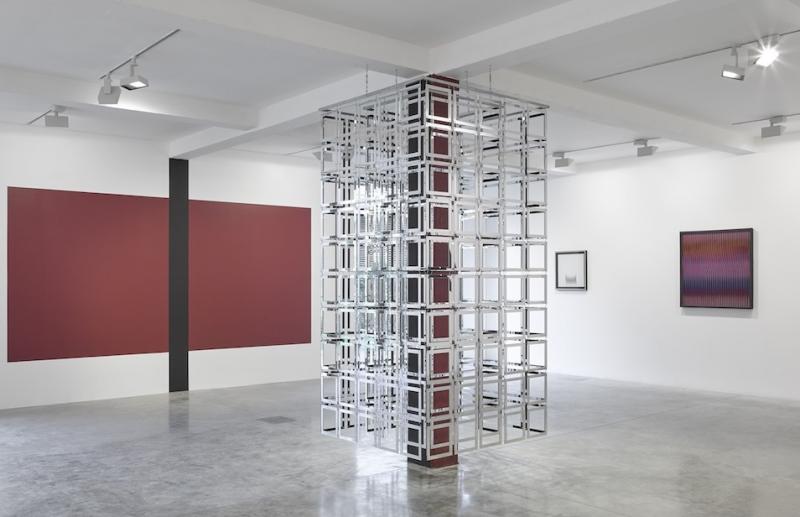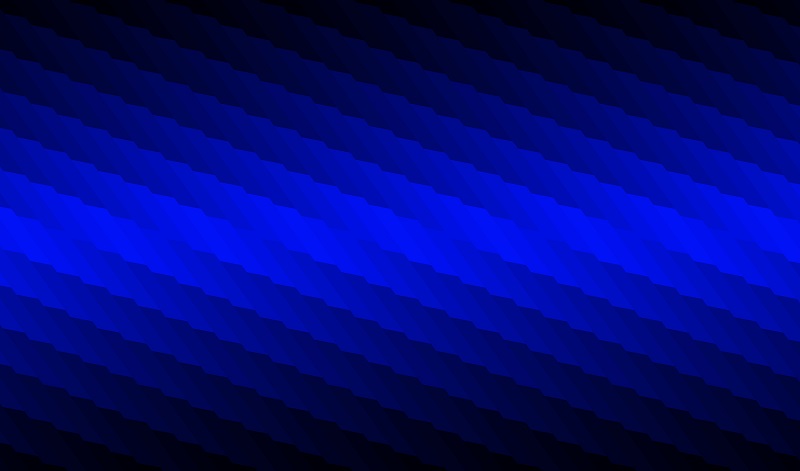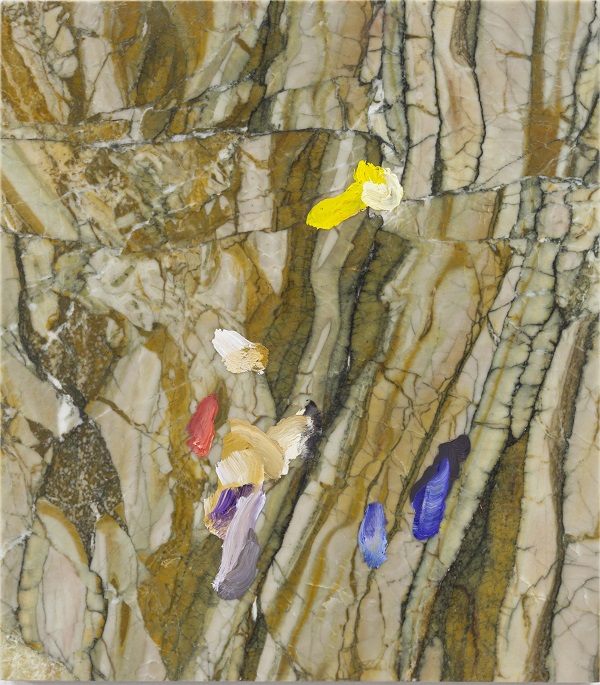The Gap: Selected Abstract Art from Belgium, Parasol Unit | reviews, news & interviews
The Gap: Selected Abstract Art from Belgium, Parasol Unit
The Gap: Selected Abstract Art from Belgium, Parasol Unit
Luc Tuymans brings an artist's eye to a survey of two generations of Belgian artists

From its title, you could be misled into dismissing this show as narrow and self-referential: a small exhibition in a small gallery curated by a Belgian artist concerned only with his own countrymen. In fact, it is something of a survey, featuring works with influences that range from Piet Mondrian, Ad Reinhardt and Lucio Fontana, to the Color Field painters.
For all its breadth, each of the 40 or so works on display has been made by a Belgian artist, a distinction that demands we consider the 15 artists here, who span two generations – the gap – in light of the prodigious artistic output of that country. Boy & Erik Stappaerts (1969–) invokes his Flemish ancestry rather clumsily in his Polarisation Paintings, 2014–15 (pictured below right: Polarisation painting, 2015), reducing what he perceives as the predominant colours of the Old Masters to discrete panels representing blue sky, red draperies, and cool and warm skin tones. The uniformly rippled effect achieved by spray painting aluminium with car lacquers mimics the look of oil glazes, while ridding them of their painterly expression. It’s a blunt instrument, and his method of abstracting a figurative mode of painting seems only to belittle it: certainly, it’s hard to imagine anyone reading it as a homage. Similarly, Gert Robijns’ (1972–) exquisitely detailed Brussels Sprout, 2012, cast in bronze and positioned on a plinth, hovers somewhere between tribute and ridicule.
 If the faithful representation of material reality was a preoccupation of Flemish painters from the 15th to the 17th centuries, the physicality of things is a concern shared with abstract art. Pieter Vermeersch, (1973–), one of the younger generation of artists here, responds to ideas explored by artists like Piet Mondrian and Ad Reinhardt, both acknowledged influences on Tuymans himself, by testing the very nature of painting itself. Vermeesch’s soft gradations of oil paint mimic the polished, reflective surface of a bare metal sheet, the painted surface appearing to be at once support and subject, utterly self-contained.
If the faithful representation of material reality was a preoccupation of Flemish painters from the 15th to the 17th centuries, the physicality of things is a concern shared with abstract art. Pieter Vermeersch, (1973–), one of the younger generation of artists here, responds to ideas explored by artists like Piet Mondrian and Ad Reinhardt, both acknowledged influences on Tuymans himself, by testing the very nature of painting itself. Vermeesch’s soft gradations of oil paint mimic the polished, reflective surface of a bare metal sheet, the painted surface appearing to be at once support and subject, utterly self-contained.
Similarly, the primary colours Vermeersch has applied to a piece of polished marble surely amount to a commentary on the failure of painting: instead of forming a legible picture plane, his marks are disengaged from their support, confusing and impeding our view. The relationship between paint and ground is disrupted, and put into a sort of limbo (Pictured below left: Untitled, 2014).
Such tensions resonate throughout this show and culminate in a column of double-sided mirrors dominating the centre of the second room, continuing up through the floor, treelike, to the upper gallery. Made by Carla Arocha & Stéphane Schraenen (1961– and 1971–), the piece simultaneously frames and reflects, partially and imperfectly, the red, yellow and blue of surrounding works (Main picture). As you move around it the view changes like a kaleidoscope, the space condensing and flattening to generate an interplay of presence and absence, positive and negative, real and unreal.
As the column seems to re-emerge in the upstairs gallery, the vivid primary colours are replaced by the colours of night: black, cool blue and a deep burgundy. In this way we are constantly drawn back to Tuymans’ own territory, the representational.
 For all the tensions and dialogues that Tuymans initiates in his selection and arrangement of works, it is his artist’s eye that prevails, producing a wonderfully good-looking show that is, nevertheless, probably greater than the sum of its parts.
For all the tensions and dialogues that Tuymans initiates in his selection and arrangement of works, it is his artist’s eye that prevails, producing a wonderfully good-looking show that is, nevertheless, probably greater than the sum of its parts.
In the downstairs gallery Tuymans’ refreshingly visual approach – by no means a given amongst today’s curators – gives rise to beautiful juxtapositions that propose intelligent and thought-provoking insights into the nature of colour and monochrome.
Upstairs however, his undoubted knack for colour co-ordination starts to look a little like interior decoration, those dusky colours and the chandelier-like mirrors of Arocha & Schraenen’s column offputtingly reminiscent of a swanky hotel lobby. But as abstract art remains unwaveringly popular in the world’s boardrooms and corporate spaces, it seems somehow fitting to point out its capacity to be easy on the eye, blandly inoffensive, all things to all people. If this is Tuymans’ parting shot, then it is elegantly done, presenting us with one of the recurring dilemmas of abstraction: is it enough for art to exist for itself, to have beauty as its principal aim?
Explore topics
Share this article
The future of Arts Journalism
You can stop theartsdesk.com closing!
We urgently need financing to survive. Our fundraising drive has thus far raised £49,000 but we need to reach £100,000 or we will be forced to close. Please contribute here: https://gofund.me/c3f6033d
And if you can forward this information to anyone who might assist, we’d be grateful.

Subscribe to theartsdesk.com
Thank you for continuing to read our work on theartsdesk.com. For unlimited access to every article in its entirety, including our archive of more than 15,000 pieces, we're asking for £5 per month or £40 per year. We feel it's a very good deal, and hope you do too.
To take a subscription now simply click here.
And if you're looking for that extra gift for a friend or family member, why not treat them to a theartsdesk.com gift subscription?
more Visual arts
 'We are bowled over!' Thank you for your messages of love and support
Much-appreciated words of commendation from readers and the cultural community
'We are bowled over!' Thank you for your messages of love and support
Much-appreciated words of commendation from readers and the cultural community
 Photo Oxford 2025 review - photography all over the town
At last, a UK festival that takes photography seriously
Photo Oxford 2025 review - photography all over the town
At last, a UK festival that takes photography seriously
![SEX MONEY RACE RELIGION [2016] by Gilbert and George. Installation shot of Gilbert & George 21ST CENTURY PICTURES Hayward Gallery](https://theartsdesk.com/sites/default/files/styles/thumbnail/public/mastimages/Gilbert%20%26%20George_%2021ST%20CENTURY%20PICTURES.%20SEX%20MONEY%20RACE%20RELIGION%20%5B2016%5D.%20Photo_%20Mark%20Blower.%20Courtesy%20of%20the%20Gilbert%20%26%20George%20and%20the%20Hayward%20Gallery._0.jpg?itok=7tVsLyR-) Gilbert & George, 21st Century Pictures, Hayward Gallery review - brash, bright and not so beautiful
The couple's coloured photomontages shout louder than ever, causing sensory overload
Gilbert & George, 21st Century Pictures, Hayward Gallery review - brash, bright and not so beautiful
The couple's coloured photomontages shout louder than ever, causing sensory overload
 Lee Miller, Tate Britain review - an extraordinary career that remains an enigma
Fashion photographer, artist or war reporter; will the real Lee Miller please step forward?
Lee Miller, Tate Britain review - an extraordinary career that remains an enigma
Fashion photographer, artist or war reporter; will the real Lee Miller please step forward?
 Kerry James Marshall: The Histories, Royal Academy review - a triumphant celebration of blackness
Room after room of glorious paintings
Kerry James Marshall: The Histories, Royal Academy review - a triumphant celebration of blackness
Room after room of glorious paintings
 Folkestone Triennial 2025 - landscape, seascape, art lovers' escape
Locally rooted festival brings home many but not all global concerns
Folkestone Triennial 2025 - landscape, seascape, art lovers' escape
Locally rooted festival brings home many but not all global concerns
 Sir Brian Clarke (1953-2025) - a personal tribute
Remembering an artist with a gift for the transcendent
Sir Brian Clarke (1953-2025) - a personal tribute
Remembering an artist with a gift for the transcendent
 Emily Kam Kngwarray, Tate Modern review - glimpses of another world
Pictures that are an affirmation of belonging
Emily Kam Kngwarray, Tate Modern review - glimpses of another world
Pictures that are an affirmation of belonging
 Kiefer / Van Gogh, Royal Academy review - a pairing of opposites
Small scale intensity meets large scale melodrama
Kiefer / Van Gogh, Royal Academy review - a pairing of opposites
Small scale intensity meets large scale melodrama
 Jenny Saville: The Anatomy of Painting, National Portrait Gallery review - a protégé losing her way
A brilliant painter in search of a worthwhile subject
Jenny Saville: The Anatomy of Painting, National Portrait Gallery review - a protégé losing her way
A brilliant painter in search of a worthwhile subject
 Abstract Erotic, Courtauld Gallery review - sculpture that is sensuous, funny and subversive
Testing the boundaries of good taste, and winning
Abstract Erotic, Courtauld Gallery review - sculpture that is sensuous, funny and subversive
Testing the boundaries of good taste, and winning
 Edward Burra, Tate Britain review - watercolour made mainstream
Social satire with a nasty bite
Edward Burra, Tate Britain review - watercolour made mainstream
Social satire with a nasty bite

Add comment